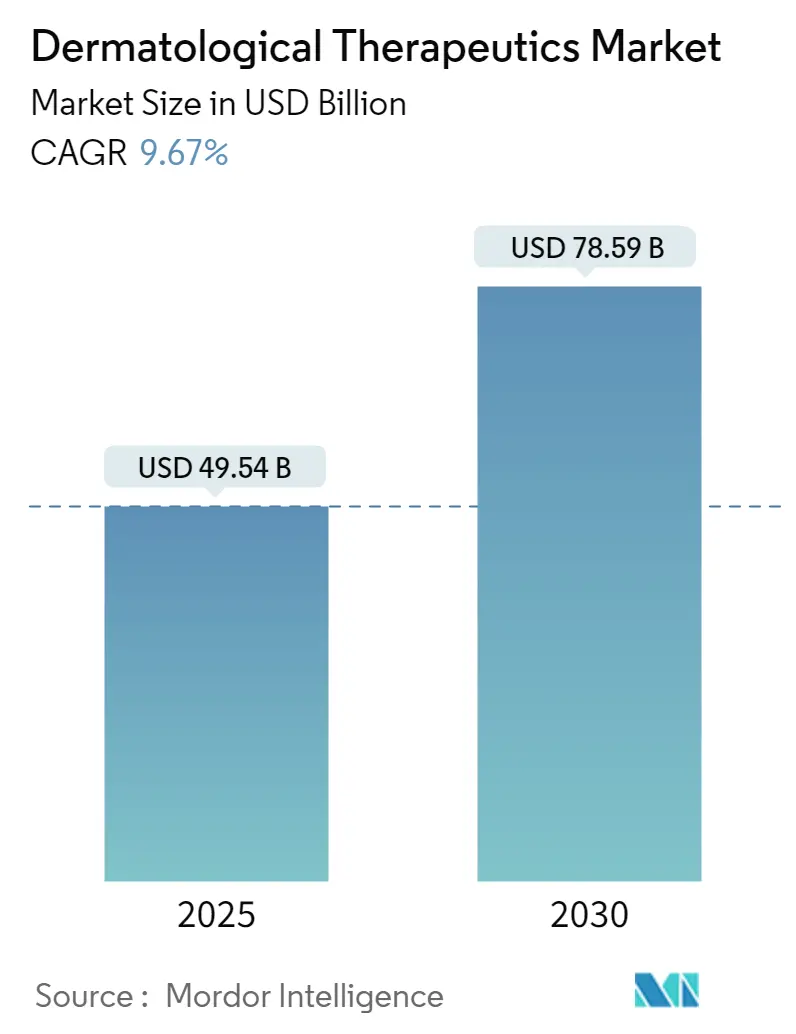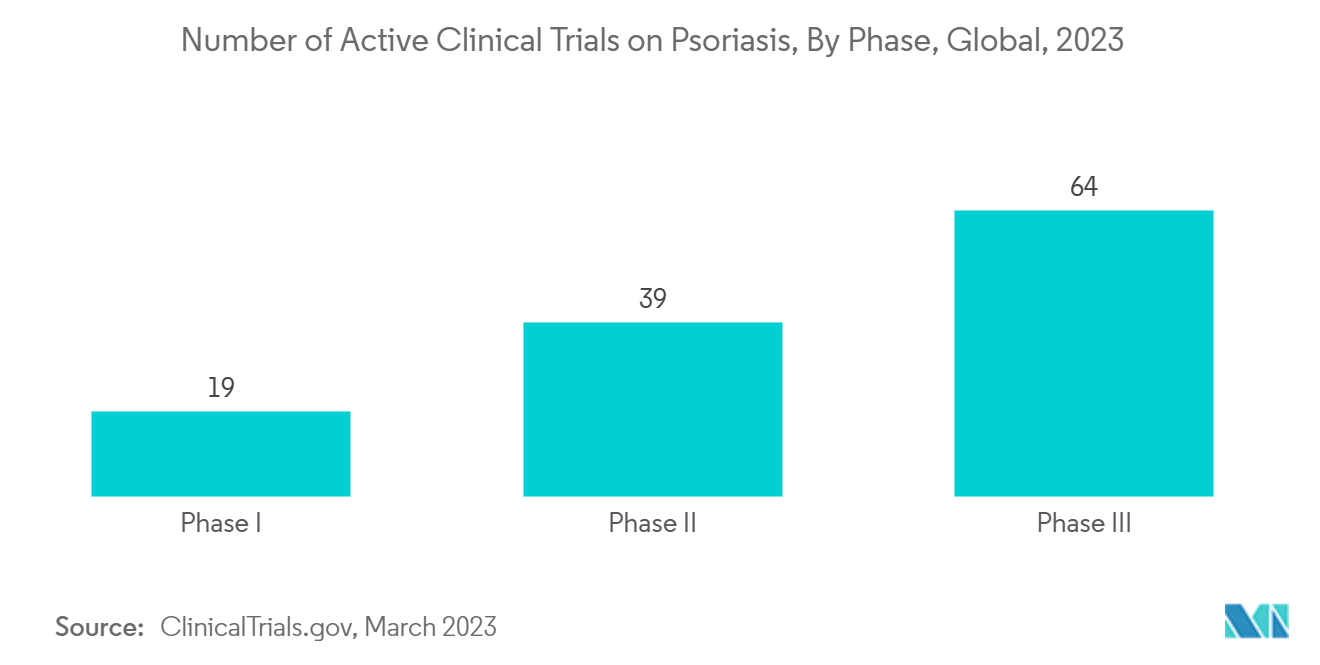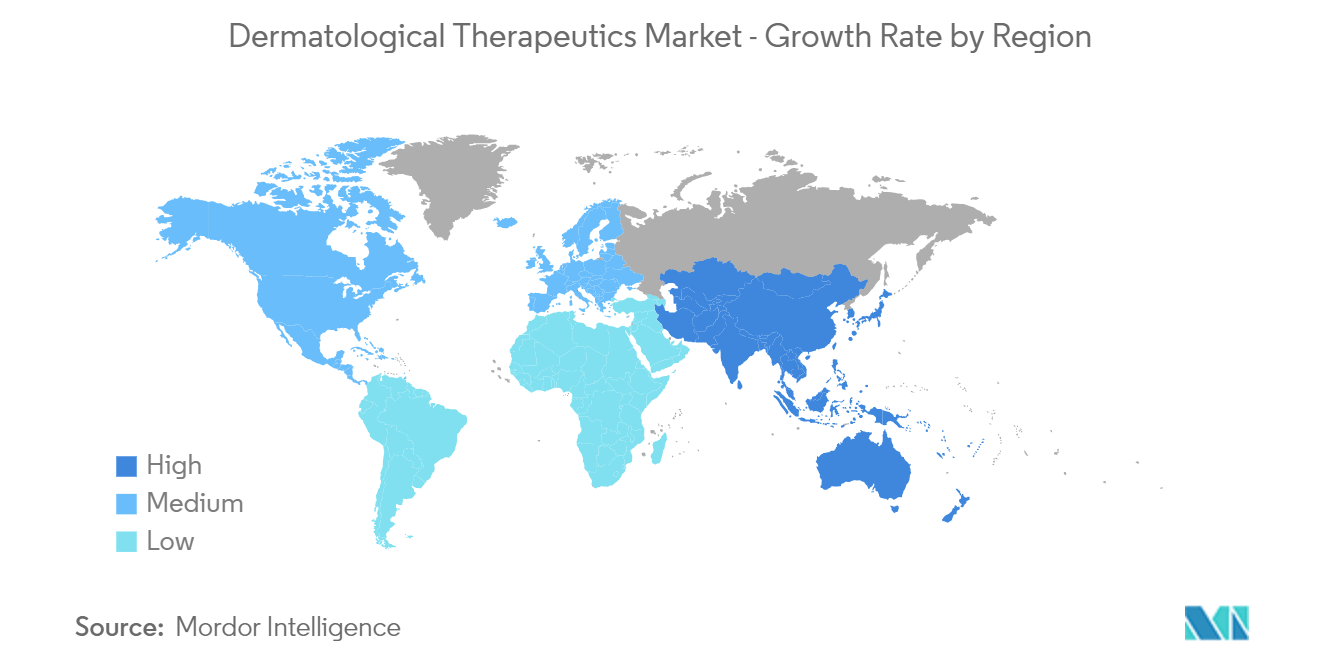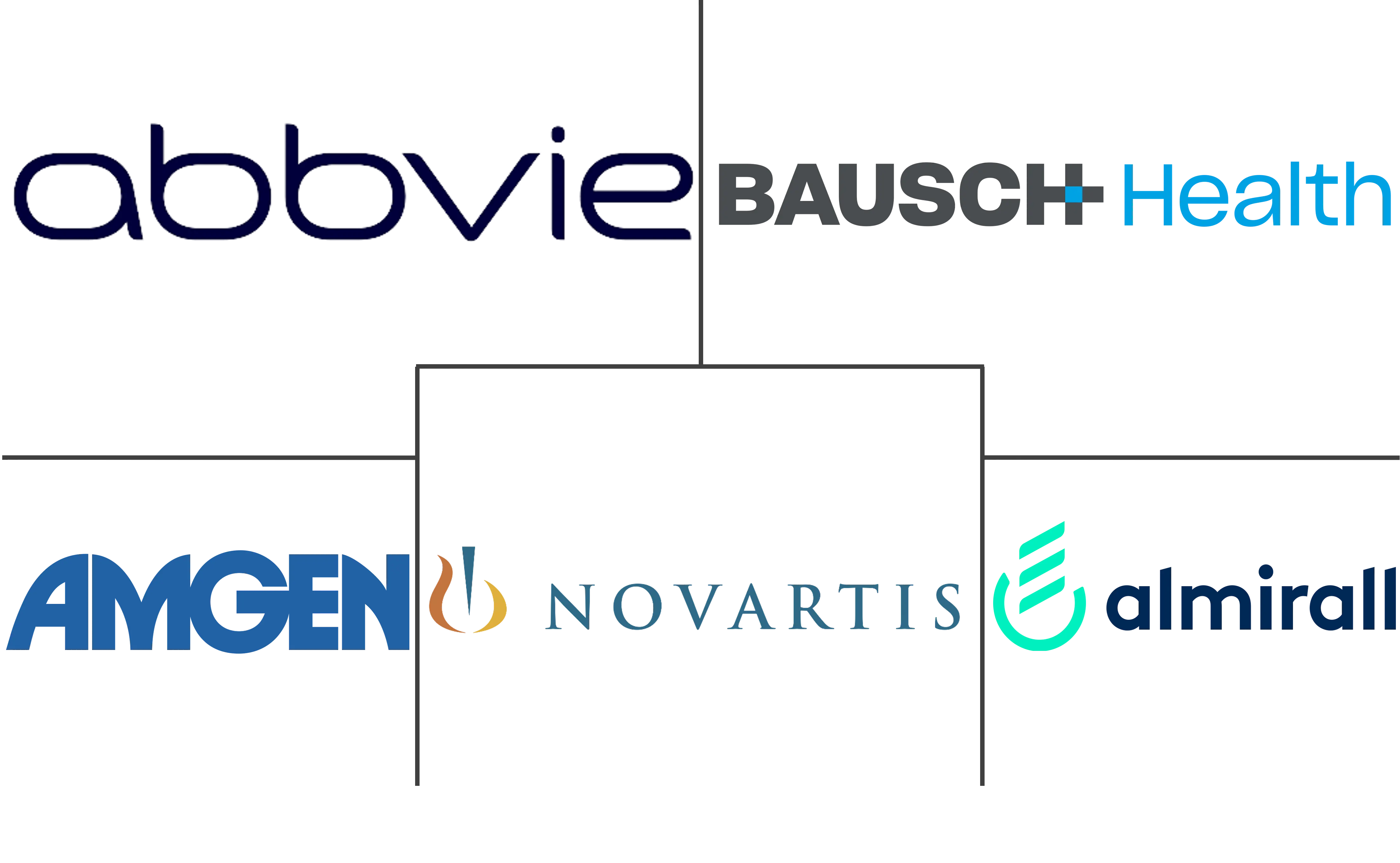
Dermatological Therapeutics Market Analysis
The Dermatological Therapeutics Market size is estimated at USD 49.54 billion in 2025, and is expected to reach USD 78.59 billion by 2030, at a CAGR of 9.67% during the forecast period (2025-2030).
Major factors driving the Dermatology Industry's growth include the growing burden of Dermatological Diseases, increased awareness levels of disease progression and etiology, and a rise in the elderly population. With the rise in the aging population worldwide, Dermatological Treatment is likely to receive particular attention. As people age, the need for effective Skin Disease Treatment increases due to factors such as changes in the connective tissue, reduction in the skin's strength and elasticity, and reduction in secretions from sebaceous glands.
For instance, according to the World Health Organization's report published in October 2023, by 2024, it had been estimated that the population of individuals aged over 65 years would outnumber those under the age of 15. By 2050, the number of people aged 65 years or over worldwide is projected to be more than twice the number of children under age five and about the same as that of children under age 12. Thus, the rising geriatric population is expected to enhance growth in the Dermatology Market.
Skin diseases have seriously impacted people's quality of life, causing productivity loss at work and other places and discrimination due to disfigurement, highlighting the importance of effective Skin Disease Treatment. According to the Global Report on Atopic Dermatitis 2022 published by the International Eczema Council in November 2022, about 223 million people were living with atopic dermatitis in 2022, of which around 43 million were aged 1-4. This shows the strikingly high prevalence among young children. In addition to the disease burden on the children and their caregivers, Atopic Dermatitis can also negatively affect the children's development, education, and work. Thus, the high prevalence and the rising burden of such Dermatological Diseases are expected to boost the Dermatology Drug Market growth.
The Dermatological Therapeutics Market is anticipated to witness lucrative growth due to collaborations, acquisitions, and new product launches by leading Dermatology Pharmaceutical Companies. For instance, in March 2023, Eli Lilly expanded its presence in the dermatological field in India by introducing a new product called Copellor. This product is designed to treat moderate-to-severe plaque psoriasis, a chronic skin condition characterized by red, raised, and scaly patches on the skin, and contributes to the growth of the Dermatological Products Market in India. The launch of Copellor in the Indian market follows the approval granted by the Drug Controller General of India (DCGI), which is the regulatory authority responsible for approving and regulating pharmaceuticals and medical devices in the country.
Thus, the increasing burden of Dermatological Diseases, the rising geriatric population, and the increasing developments by key market players are expected to shape the Dermatology Industry Trends over the forecast period. However, serious side effects of certain classes of therapeutic drugs are expected to restrain the market in the near future.
Dermatological Therapeutics Market Trends
Psoriasis Segment Expected to Hold a Significant Market Share Over the Forecast Period
Psoriasis is a chronic autoimmune skin disease that speeds up the growth cycle of skin cells. It causes patches of thick red skin and silvery scales on the elbows, face, palms, knees, scalp, lower back, and soles of feet. The most common type of psoriasis is plaque psoriasis, and misguided T-cell attacks on the skin cause it. The rising prevalence of psoriasis, the increasing number of clinical trials for psoriasis drug development, and rising developments by major market players are expected to boost the Psoriasis Treatment Market growth.
The rising prevalence of psoriasis is a major factor driving the segment. For instance, according to the data updated by the National Psoriasis Foundation in December 2022, around 125 million people worldwide had psoriasis in 2022, almost equal to 2-3% of the total population. The source also stated that more than 8 million US citizens had psoriasis in 2022. Thus, the high prevalence of psoriasis is expected to boost the adoption of Dermatology Medicines. As psoriasis is often associated with the elderly, the rising geriatric population is also expected to drive segmental growth.
As per the data published by clinicaltrials.gov, in February 2024, approximately 272 ongoing phase 4 clinical trials were being conducted for the treatment of psoriasis. These are expected to receive approvals for the treatment of the disease in the coming future, including new Topical Therapeutics, thus driving the growth of the Dermatology Drugs Market.
New product launches and the focus of market players on expanding their market share in the Autoimmune Dermatology Ointment Market through collaborations and acquisitions are anticipated to boost the segment. For instance, in November 2023, Lord's Mark Biotech, a subsidiary of Lord's Mark Industries, launched Tinefcon, a patented medicine for treating psoriasis.
Thus, due to factors such as the rising prevalence of psoriasis, the growing geriatric population, increasing developments by key players, and the rising number of psoriasis clinical trials, the Psoriasis Treatment Market segment is expected to witness steady growth over the forecast period.

North America Expected to Hold a Significant Market Share Over the Forecast Period
North America is expected to hold a significant market share due to increasing healthcare expenditure, growing awareness about skin diseases, and the strong presence of Dermatology Pharmaceutical Companies.
The rising prevalence of Dermatological Diseases is a major factor expected to boost the market in the region. For instance, according to a report published by the World Allergy Organization Journal in March 2023, the prevalence of atopic dermatitis was between 4.9% and 10.2% in the United States. Thus, the high prevalence of such Dermatological Diseases is expected to boost the adoption of Dermatological Therapeutics in the country.
The rising geriatric population is also significantly driving the Dermatological Drugs Market growth. For instance, according to a census report published by Statistics Canada in April 2022, the population aged 85 and older is one of the fastest-growing age groups, with over 2.3% of the population aged 85 and older.
The new product launches by key regional market players are also anticipated to boost the market's growth. For instance, in May 2023, the US Food and Drug Administration approved Krystal Biotech Inc.'s first-of-its-kind topical gene therapy, enhancing the Dermatological Treatments available. Similarly, in July 2023, the FDA approved Verrica Pharmaceutical's Ycanth topical solution for the treatment of the viral skin infection molluscum contagiosum in patients aged as young as two years, contributing to the Dermatology Drug Market. Thus, rising product launches by key market players are mainly driving the North American market.
Thus, due to factors such as the rising prevalence of Dermatological Diseases, the rising geriatric population, and the increasing developments by key market players, the market is expected to witness steady growth in the region over the forecast period.

Dermatological Therapeutics Industry Overview
The Dermatological Therapeutics Market is fragmented in nature. With the available growth opportunities, many new players are emerging among Dermatology Pharma Companies. Forthcoming patent expiries of major drugs are leading to increased competition, further driving the Dermatological Drugs Market, especially in the generic drugs industry. The Dermatological diagnostics and therapeutics market is expected to grow tremendously, with several generic players controlling a significant share in markets across developing regions, reflecting current Dermatology Industry Trends. Some prominent market players include leading Dermatology Pharmaceutical Companies such as Amgen Inc., Bausch Health Companies Inc., Novartis AG, AbbVie Inc., and Almirall SA.
Dermatological Therapeutics Market Leaders
-
Amgen Inc.
-
Bausch Health Companies Inc.
-
Novartis AG
-
AbbVie Inc.
-
Almirall SA
- *Disclaimer: Major Players sorted in no particular order
Dermatological Therapeutics Market News
- February 2024: Alys Pharmaceuticals launched its research and development (R&D) immuno-dermatology-focused pipeline, backed by a USD 100 million financing from Medicxi.
- October 2023: Novartis received approval from the US Food and Drug Administration (FDA) for Cosentyx (secukinumab) to treat moderate to severe hidradenitis suppurativa (HS) in adults. Cosentyx is one of the first FDA-approved fully human biologics that directly inhibits interleukin-17A (IL-17A), a cytokine believed to be involved in the inflammation of HS.
Dermatological Therapeutics Industry Segmentation
As per the scope of the report, dermatological therapeutics are drugs used to treat and prevent various dermatological conditions. The dermatological therapeutics market is segmented by application, drug class, and geography. By application, the market is segmented into alopecia, herpes, psoriasis, rosacea, atopic dermatitis, and other applications. By drug class, the market is segmented into anti-infectives, corticosteroids, anti-acne, calcineurin inhibitors, retinoids, and other drug classes. By geography, the market is segmented into North America, Europe, Asia-Pacific, the Middle East and Africa, and South America. The report also covers the estimated market sizes and trends for 17 countries across major regions globally. The report offers the market sizes and forecasts in terms of value (USD) for the above segments.
| By Application | Alopecia | ||
| Herpes | |||
| Psoriasis | |||
| Rosacea | |||
| Atopic Dermatitis | |||
| Other Applications | |||
| By Drug Class | Anti-infectives | ||
| Corticosteroids | |||
| Anti-acne | |||
| Calcineurin Inhibitors | |||
| Retinoids | |||
| Other Drug Classes | |||
| By Geography | North America | United States | |
| Canada | |||
| Mexico | |||
| Europe | Germany | ||
| United Kingdom | |||
| France | |||
| Italy | |||
| Spain | |||
| Rest of Europe | |||
| Asia-Pacific | China | ||
| Japan | |||
| India | |||
| Australia | |||
| South Korea | |||
| Rest of Asia-Pacific | |||
| Middle East and Africa | GCC | ||
| South Africa | |||
| Rest of Middle East and Africa | |||
| South America | Brazil | ||
| Argentina | |||
| Rest of South America | |||
Dermatological Therapeutics Market Research FAQs
How big is the Dermatological Therapeutics Market?
The Dermatological Therapeutics Market size is expected to reach USD 49.54 billion in 2025 and grow at a CAGR of 9.67% to reach USD 78.59 billion by 2030.
What is the current Dermatological Therapeutics Market size?
In 2025, the Dermatological Therapeutics Market size is expected to reach USD 49.54 billion.
Who are the key players in Dermatological Therapeutics Market?
Amgen Inc., Bausch Health Companies Inc., Novartis AG, AbbVie Inc. and Almirall SA are the major companies operating in the Dermatological Therapeutics Market.
Which is the fastest growing region in Dermatological Therapeutics Market?
Asia Pacific is estimated to grow at the highest CAGR over the forecast period (2025-2030).
Which region has the biggest share in Dermatological Therapeutics Market?
In 2025, the North America accounts for the largest market share in Dermatological Therapeutics Market.
What years does this Dermatological Therapeutics Market cover, and what was the market size in 2024?
In 2024, the Dermatological Therapeutics Market size was estimated at USD 44.75 billion. The report covers the Dermatological Therapeutics Market historical market size for years: 2021, 2022, 2023 and 2024. The report also forecasts the Dermatological Therapeutics Market size for years: 2025, 2026, 2027, 2028, 2029 and 2030.
Our Best Selling Reports
Dermatological Drugs Industry Report
Statistics for the 2025 Dermatological Therapeutics market share, size and revenue growth rate, created by Mordor Intelligence™ Industry Reports. Dermatological Therapeutics analysis includes a market forecast outlook for 2025 to 2030 and historical overview. Get a sample of this industry analysis as a free report PDF download.




